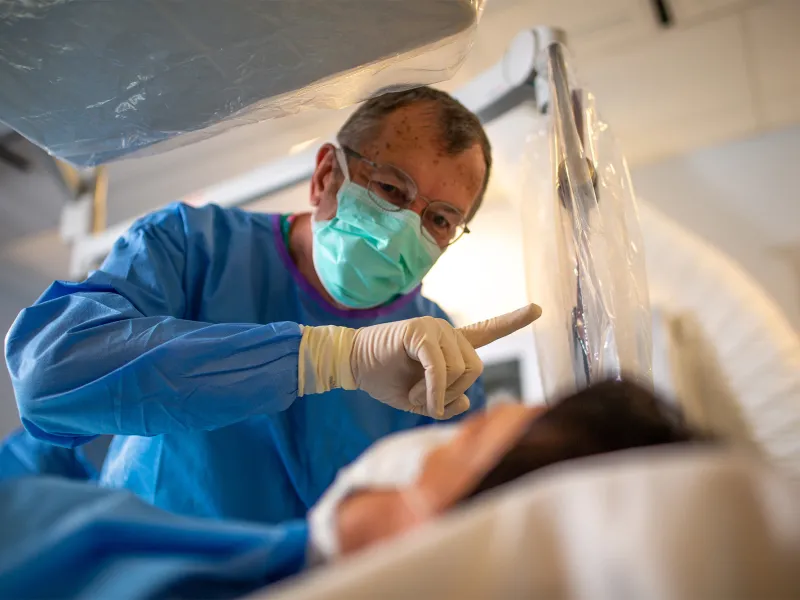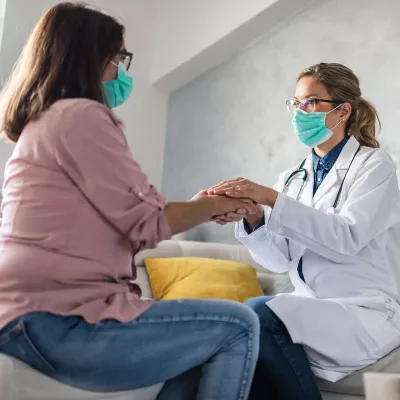
Advanced Moyamoya Care for You
Moyamoya is a rare condition — and a serious one, too. But our neurosurgeons have expertise and experience you can rely on.
Here, you and your loved ones will have access to the most up-to-date treatments and whole-person care, with the guidance and attention you deserve for your physical, mental and spiritual needs.
Understanding Moyamoya Brain Disease
- What Is Moyamoya?
-
Moyamoya, also known as moyamoya disease, is a progressive condition that affects the brain’s blood vessels. Seen most often in children (though it can affect adults as well), moyamoya is serious because it can result in debilitating strokes and mental decline.
The disease develops when the arteries at the base of your brain become narrowed or blocked. To get more blood to the brain, a tangled group of tiny vessels form near the blockage and resemble a “puff of smoke,” — the Japanese translation of moyamoya.
- Moyamoya Disease Symptoms
-
Many times, the first symptom of moyamoya disease in a child is a stroke or recurrent transient ischemic attacks (TIA), also known as mini strokes. Weakness or paralysis on one side of the body may accompany these strokes.
Adults may experience similar symptoms if their arteries are blocked. However, they are more likely to have hemorrhagic strokes, which happen when there is bleeding in the brain.
Other moyamoya symptoms can include:
- Altered consciousness
- Cognitive or sensory impairment
- Headaches
- Involuntary movements
- Seizures
- Vision difficulties
- Moyamoya Diagnosis
-
If you or a loved one have symptoms of moyamoya, a physical exam and review of your personal and family medical history with a doctor is the first step in getting a diagnosis. The doctor may recommend one or more tests, including:
- Cerebral angiography: allows doctors to see your blood vessels with X-ray imaging
- Computed tomography (CT) scan: takes multiple X-rays and puts them together to create detailed images of your brain
- Electroencephalography (EEG): evaluates the brain’s electrical activity with the aid of electrodes attached to the scalp (especially helpful for children with moyamoya symptoms)
- Magnetic resonance imaging (MRI): uses strong magnets and radio waves to create detailed brain images, and a perfusion MRI measures blood flow through your blood vessels
- Positron emission tomography (PET) scan: involves injecting safe amounts of a radioactive substance into the body and using special detectors to show brain activity
- Single-photon emission computed tomography (SPECT): measures blood flow to different brain regions
- Transcranial doppler ultrasound: uses sound waves to generate information about the brain’s blood vessels
- Moyamoya Treatment
-
Medication may help lower the risk of a stroke, but surgery is the recommended moyamoya disease treatment.
Our neurosurgeons specialize in advanced surgical procedures that restore blood flow to your brain and help prevent a stroke. Some procedures open narrowed blood vessels, while others help increase blood flow around blocked vessels.
Moyamoya surgery procedures we offer include:
Direct Revascularization
Direct revascularization involves connecting a branch of a scalp artery to a branch of the blocked artery on the outer surface of the brain, which immediately improves blood flow.
Indirect Revascularization
Indirect revascularization can be used to increase blood flow to the brain in one of two ways:
- Encephalo-duro-arterio-synangiosis (EDAS) involves laying a branch of your temporal artery directly on the surface of your brain without making a direct connection, in order to create a new supply of blood
- Encephalo-myo-synangiosis (EMS) involves dissecting the temporalis muscle and placing it on the surface of the brain (a new blood supply will develop from the transferred muscle)
Omental-Cerebral Transposition
This involves laying the lining that surrounds your abdominal organs onto the surface of the brain, causing new blood vessels to develop, grow and flow into the brain.
On average, most of our patients spend three days in the hospital after moyamoya surgery. You’re likely to have some pain at the incision site on your scalp, and you may experience headaches during your recovery. However, once you leave the hospital, it’s likely you’ll be able to return to the activities that are important to you with minimal restrictions.
Whole-Person Healing Is Our Focus
Caring Experts
- Neurologists
- Neurosurgeons
- Nurses
- Occupational Therapists
- Pastoral Care Providers
- Physical Therapists
- Psychologists
- Radiologists
- Speech Therapists
Advanced Surgical Treatments
- Direct Revascularization
- Indirect Revascularization
- Encephalo-duro-arterio-synangiosis
- Encephalo-myo-synangiosis
- Omental-Cerebral Transposition
Resources and Support

Set Your Sights on Wellness
If you or a loved one have symptoms of moyamoya disease or if you’ve already been diagnosed with the condition, we’re here to help. Our highly skilled team will give you the personalized attention and responsive care you need for the best possible outcome and return to optimal health.
